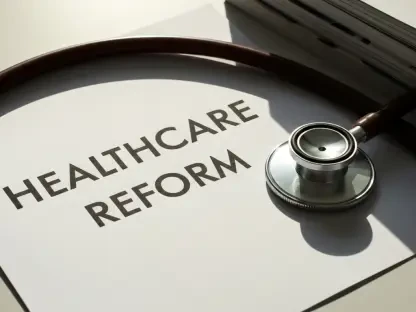In recent legislative discussions, the U.S. House of Representatives has been working on significant changes to health care policies related to Medicaid and the Affordable Care Act (ACA). Faisal Zain, a noted expert in healthcare and medical technology, shares his insights into the possible ramifications of these proposed changes. With vast experience in the field, Faisal provides a thorough analysis of the potential impacts on healthcare accessibility and coverage.
What are the key components of the House bill discussed by the Energy and Commerce Committee concerning Medicaid and the Affordable Care Act?
The House bill under discussion is a significant piece of legislation that proposes substantial reductions to health programs, estimating cuts of around $715 billion over the next decade. These reductions primarily target Medicaid, making it the largest proposed cut in the program’s 60-year history, although some reductions will also impact the Affordable Care Act. One dominant component of the bill is the introduction of work requirements for Medicaid, a long-time goal for Republicans. While previous attempts to pass such requirements were halted by the courts, current conditions might lead to a different outcome.
Can you explain the concept of work requirements for Medicaid and their potential impact on enrollees?
At their simplest, work requirements mandate that Medicaid enrollees must meet certain work-related conditions, such as being employed or participating in job training, to maintain their healthcare coverage. The goal, according to proponents, is to encourage self-sufficiency. However, past experiences in states like Arkansas and Georgia show that these requirements did not significantly increase employment rates but did result in eligible people losing their coverage. This typically happens because people are unable to navigate the paperwork and administrative processes involved, and they risk losing vital health services as a result.
How do the proposed Medicaid copays aim to affect health coverage, and who would be most impacted by these changes?
The bill proposes imposing Medicaid copays up to $35 for individuals with incomes just over 100% of the poverty level but still under the Medicaid qualification level of 138% of the poverty line. Although primary care and emergency services are excluded, which respectfully maintains accessibility to basic healthcare, the copays for other types of care can be burdensome for people with limited income. The body of research suggests that imposing copays can reduce the number of services people use, which could in turn affect those who may not have the financial flexibility to afford these additional costs.
Could you elaborate on the budgetary implications of the proposed Medicaid and ACA cuts, particularly the projected $715 billion reductions?
The projected $715 billion in reductions largely comes from proposed cuts to Medicaid and some to the ACA. This bill refrains from targeting the 90% federal match for the ACA expansion population and avoids imposing a per capita cap. Nevertheless, this would still rank as the largest cut in Medicaid’s history. Beyond direct cuts, the bill includes implementing stricter verification processes and introducing supplemental costs that could lead more individuals to lose coverage, thus reducing federal spending but potentially impacting millions who rely on these programs for healthcare.
How might the proposed Medicaid work requirements affect employment among recipients, according to past state experiences?
From past experiments, particularly in Arkansas and Georgia, we’ve learned that such work requirements do not result in increased employment among Medicaid recipients. Instead, they often lead to people losing their healthcare coverage, not because they refuse to work, but because they stumble over the complex paperwork needed to prove their compliance. Thus, while the intended effect is to encourage employment, the real impact seems to be cutting costs by reducing the number of people eligible for Medicaid.
What role did Massachusetts Democratic Rep. Jake Auchincloss play in the hearing, and what was his stance on work requirements?
Massachusetts Democratic Rep. Jake Auchincloss was quite vocal during the hearing. He criticized the proposed work requirements, labeling them more as ‘paperwork requirements’ rather than actual incentives for employment. Auchincloss and many other Democrats stressed that work requirements are ineffective at improving employment rates and primarily serve to strip people of their healthcare coverage due to bureaucratic hurdles.
What are some of the major changes proposed to the Affordable Care Act under this bill?
The bill proposes several significant changes to the ACA. It plans to shorten the open enrollment period, restrict automatic reenrollment, and eliminate special enrollment periods for low-income individuals. Moreover, it would require more stringent income verification processes. The intention behind these changes is to reduce government spending by curtailing enrollment opportunities, which would likely lead to fewer people maintaining their health insurance coverage.
How are special enrollment periods and automatic reenrollment for ACA plans addressed in the House bill?
The House bill tackles special enrollment periods and automatic reenrollment by proposing to bar the former for low-income individuals and enforce stricter verification for the latter. The automatic reenrollment ban would mean that individuals who rely on this process would have to actively verify their eligibility to continue coverage, which may result in many people losing their insurance if they fail to complete the necessary steps.
Why are the enhanced tax credits under Biden’s administration significant, and what could happen if they expire?
The enhanced tax credits introduced under Biden’s administration expanded support at both ends of the income spectrum. By smoothing out the 400% poverty level cutoff, many people gained better access to subsidized health insurance. If these enhanced subsidies expire without congressional action, we could see a significant increase in premiums, potentially discouraging millions from renewing their coverage. This could lead to about 5 million people losing their insurance due to unaffordable premiums.
What potential effects could the bill have on the number of uninsured individuals in the U.S.?
The combination of reduced enrollment periods, the removal of special enrollment opportunities, enforced income verification, and the expiration of enhanced tax credits are set to significantly diminish the number of insured individuals. Even without the enhanced subsidies, which we’ve anticipated might not be renewed, the other changes will likely lead to a noticeable drop in the insured rate in the U.S., unwinding some of the progress made under the ACA.
How does the bill approach the issue of defunding organizations like Planned Parenthood, and what are the implications of such measures?
The bill includes provisions to bar Planned Parenthood from the Medicaid program, a move that could potentially disrupt access to reproductive and other health services for those who rely on Planned Parenthood as a primary healthcare provider. Previous analyses indicated that such a measure might not yield the intended budgetary savings, as reduced access to affordable contraception could result in higher costs for unintended pregnancies.
What were the main points of contention during Health and Human Services Secretary Robert F. Kennedy Jr.’s testimony before Congress?
HHS Secretary Robert F. Kennedy Jr.’s testimony generated significant contention, particularly concerning accusations of withholding congressionally appropriated funds. This highlighted a fundamental conflict over the separation of powers, with congressional leaders, especially Rep. Rosa DeLauro, accusing the administration of overstepping its authority by not disbursing funds according to legislative mandate. The debates also touched on claims of promoting pseudoscience and questioned the administration’s handling of public health policies.
How did Secretary Kennedy address accusations about withholding congressionally appropriated funds during his testimony?
During his testimony, Secretary Kennedy repeatedly insisted that he was ready to allocate funds once Congress appropriated them. However, this assertion contradicted the fact that the funds had already been appropriated, culminating in visible frustration from lawmakers like Rep. DeLauro. This back-and-forth underscored a significant procedural and legal impasse between Congress and the administration regarding budget allocation and execution.
What are the potential implications for scientific research if the proposed budget cuts to agencies like NIH are implemented?
The proposed budget cuts to agencies such as the National Institutes of Health (NIH) could profoundly impact scientific research. Such reductions could result in fewer resources for current projects and slow the training of future researchers due to cuts in university grants. This would potentially delay advancements in critical areas like cancer and Alzheimer’s research, jeopardizing long-term public health objectives.
How is the issue of fluoride supplements, recently addressed by the FDA, reflective of wider governmental changes to health recommendations?
The FDA’s move to ban fluoride supplements despite longstanding public health recommendations underscores wider governmental shifts towards prioritizing different perspectives on health interventions. This action contradicts more than half a century of scientific consensus on the benefits of fluoride in preventing dental decay. Such steps raise broader concerns about public health policies potentially moving away from well-established evidence-based practices.
How does the recent “study” on the abortion pill mifepristone factor into the debate about its safety and regulation?
The so-called “study” on the abortion pill mifepristone, although lacking peer review and having been published by a conservative think tank, has become a tool in the regulatory debate over mifepristone’s safety. It has prompted political figures and health officials to call for reevaluating the drug’s status, despite its long-established track record of safety and effectiveness according to numerous rigorous studies. This reflects a critical and ongoing political battle over abortion rights and access to related medications.
What is the legislative status of the new Texas anti-abortion bill, and how does it aim to circumvent judicial review?
The new Texas anti-abortion bill represents a continued effort to implement strict abortion regulations while evading judicial scrutiny. By allowing individuals to sue those they suspect of providing or facilitating access to abortion pills, the bill mirrors previous Texas legislation that attempted to bypass state enforcement, thereby limiting avenues for legal challenges. The bill’s passage remains pending, as it still requires approval from the Texas House.
How was President Trump’s executive order on drug pricing framed in terms of its effectiveness?
President Trump’s executive order on drug pricing was framed with an optimistic rhetoric suggesting it would lead to significant reductions by tying U.S. drug prices to those in other countries with price controls. However, this declaration appears more symbolic than actionable, as the complexities of drug pricing negotiations and international price controls pose significant implementation challenges.
What measures might the administration take to lower drug prices, and how realistic are these proposals?
The administration has floated various proposals aimed at reducing drug prices, but many face practical hurdles and require substantial legislative or regulatory changes to take effect. While public sentiment is overwhelmingly in favor of lowering drug costs, translating that wish into tangible policy outcomes has proved challenging, especially given the complexities of the pharmaceutical market and political gridlock.
What is your forecast for the field of medical technology amidst these proposed healthcare policy changes?
The landscape for medical technology could face both challenges and opportunities amidst the proposed healthcare policy changes. On one hand, budget cuts could hinder research and development, potentially slowing innovation. On the other, there may be increased opportunities for cost-effective technology to address gaps in care resulting from policy shifts, such as those affecting Medicaid and ACA coverage. As always, adaptability and innovation will be key in navigating these evolving circumstances.









